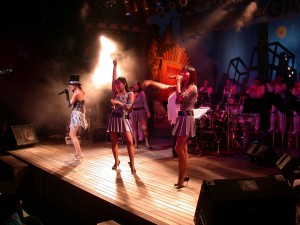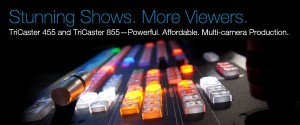WebCasting Concerts with the TriCaster 855
WebCasting “Pay Per View” is the Hottest New Trend in the Music Biz

The concert, music theater and cabaret scene in New York City and Hollywood are increasingly turning to TriCaster technology to record and live stream music events of all types.
It just makes good sense to turn to the terrific, cost saving advantages of TriCaster and Vazztcast technology.
The idea that you can replace a huge, expensive production truck with all it’s cables run from outside the venue all the way to cameras all over the theater with a small road case TriCaster close to the action is a powerful incentive to video production professionals everywhere.
By Vanessa Ventura

The fact that thanks to NewTek, smart video. crews can roll in and set up a TriCaster shoot so cost-effectively is the reason that small venues with very limited production funds can afford to live steam a modest musical event. And we see more and more savvy directors and producers turning away from the production truck and toward units like the Tricaster 450 (TCXD 450), Tricaster 850 (TCXD 850) and Tricaster 300 (TCXD 300).
For musical events we generally prefer to use a mixture of Panasonic cameras. First let me say I have no special love for Panasonic, I actually prefer the Red or Sony for non sports and non music events. But my TriCaster based, streaming video events are usually covered by my team with Panasonic Varicams and HPX 170 . We like the Varricams for the tripod work and the smaller units for hand held.
I love to get the musicians to rehearse with make up and wardrobe so I can get right up there on stage without blocking an audience view and get the really dynamic close-up shots I love. Now obviously there is a sync issue here as we are dealing with music. What I get are shots of the faces, feet rhythm of the percussion, shots of brass, and other instruments that don’t immediately cause a sync issue…
Basically anything I can to convey the emotion of the piece.
I’ll either go hand held or use a slider to get dynamic camera movement in rehearsal.
By getting this material early I gain several things:
I get dynamic shots not easily gotten during the streamed performance where I risk not only blocking the audience but blocking other cameras as well.
I can load these shots in the correct play list order of the musical event. Then I call them up from the internal DVR of my TriCaster 450 Extreme (TCXD 450) during the live stream so I have all that additional material.
I gain the advantage of having four cameras up close and hand held and then later during the live performance using those same cameras on sticks further back in the venue. So my TriCaster 450 Extreme (TCXD) effectively becomes a TriCaster 850 Extreme. Thus my clients pay for the less expensive machine but gain the advantages of the far more costly TriCaster 850.not to mention the fact that production gets the same great 8 camera results with four less cameras, four less cameramen and four less cable pullers. it’s a total win win.
The downside, over and over I have explained to bands and their managers the wisdom of the full dress rehearsal so I get the great close ups that their fans will love, that will make the video, really rock. They always nod in agreement and then at least 50% of the time one or more of the band will not wear what they do later in the live performance. my cameramen obviously don’t know this until it’s too late during the live performance streaming throughout the TriCaster. So, I can’t cut to all that great footage I spent so much time and energy capturing earlier that day. The shoot suffers but mostly the careless band members screw up their own video.
The other issue is lighting. It is essential to get in contact and establish a report with the dude on the lighting console. Two important reasons: One the rehearsal lighting must match the performance for proper continuity in the video. They need to turn off the damn house lights and co through the full lighting sequence. This is extra work and the lighting tech is often just too lazy or just unwilling to go for it. If I can’t get agreement after I explain how necessary it is for the success of the show, I got to the venue owner or his rep or the sponsor or whomever pays the lighting director and make my case there.
I explain how it’s win win for all concerned to have double the amount of great material.
The second factor is lighting levels. The musical events are often dark and moody with random revolving spots, etc, not enough light for all the depth of field the cameras would like to keep rapidly moving band members or lead singer in proper focus.
The low light forces the cameras to run with lenses wide open which is not using the glass to optimal advantage.
I can’t tell you how many times after looking me dead in the eye and promising all the light levels I requested the damn LD perversely just goes back to his accustomed low levels of crap lighting for the live stream. So beg him, bribe him , reason with him make him realize how critical the right light is for good video and a great live stream.

The extreme versions of the TriCaster 450 and TriCaster 850 are important as beyond the live streaming the clients invariably want a n enhanced version of the performance for VOD and posting on YouTube as well as their own website. So we use the iso camera material to cut into the final TriCaster output.
Next issue I usually put a TelePrompTer on the fixed camera in front of the lead singer as well as stage monitors right and left down stage
So, to recap. The TriCaster 450 extreme rather than our 850 is my most frequent go to device for most concerts where cost is a major factor. We can double the cameras effectiveness by shooting a full dress rehearsal as long as we insure that band and lighting tech cooperate. If there are an issue there or if clients have a bigger budget, then we go for the TriCaster 850 Extreme.
